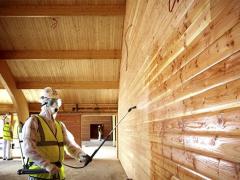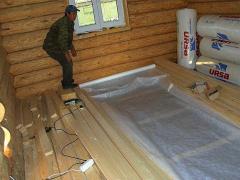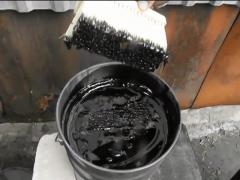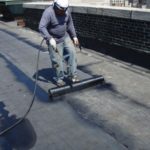Discussing the main types of wood waterproofing and the ways of performing it in a proper way.
 Wood is the most popular and indispensable construction material thanks to its excellent technical properties. But, just as any other coating, it is characterized by some disadvantages. The most important of them is timber’s instability to moisture – as a result it has a tendency to rot and mold. Wood waterproofing performed in a proper way will protect your house and will let it serve you for long.
Wood is the most popular and indispensable construction material thanks to its excellent technical properties. But, just as any other coating, it is characterized by some disadvantages. The most important of them is timber’s instability to moisture – as a result it has a tendency to rot and mold. Wood waterproofing performed in a proper way will protect your house and will let it serve you for long.
Before you choose the best waterproofing for wood of your house, you can learn some main waterproofing rules. There are some general requirements for wood waterproofing process:
The protective layer has to:
 be carried out in a certain way using special waterproofing compounds which do not contain any harmful toxic substances;
be carried out in a certain way using special waterproofing compounds which do not contain any harmful toxic substances;- protect the wood from moisture, steam and other similar effects, both natural and non-natural;
- provide the maximum moisture resistance;
- be easy to apply, quick to dry;
- create the dense invisible membrane on the surface;
- be covered with a layer of waterproof decorative plaster, tile or any other building material having a solid resistant to moisture;
- be characterized by improved stability and good adhesion to any other building materials.
The protective layer has not to:
 change its specifications over the time under influence of high temperatures and other factors;
change its specifications over the time under influence of high temperatures and other factors;- emit toxic substances which are dangerous to human health and the environment;
- lose its properties for at least 5-6 years.
There are several groups of wood waterproofing materials:
- waterproofing paint/waterproofing spray;
- wood pasting;
- cement compositions;
- penetrating waterproofing.
Painting waterproofing
You can use bitumen or polymer sealant or emulsion which must be covered in 2-5 layers using special tools (for example, by “Behr”). It usually creates the coating which has a solid resistant to mechanical, chemical and environmental impacts. It is easy in application, has durability and rather normal density. It is characterized by quite good fire, wear, steam, water, UV radiation resistance. It may be used in any climatic conditions. The main advantage of this kind of wood waterproofing is creating a solid coating which prevents the ingress of moisture in the joints and seams.
Wood pasting
These are bitumen or polymer materials which form a continuous film (waterproof carpet) stuck or surfaced in several layers on the surface of the wooden structure. They are characterized by water and water vapor permeability, resistance to mechanical and natural impacts, have a long life, easy maintenance and affordability. They are glued to the wooden surface with a hot or cold mastics. The main advantage of this kind of wood waterproofing is its accessibility. An important drawback is the possible ingress of water through the joints.
Cement compositions
The most popular cement compositions for wood waterproofing are hot bitumen and pitch. They are poured on the pre-roofed sheet or roll waterproofing, such as prepared roofing paper or other materials reinforced with fiberglass. After hardening they form another additional layer of waterproofing – which has no joints and seams and is resistant to moisture, sunlight and mechanical stress – on the wooden surface. The main advantages of this kind of wood waterproofing are ease of application, endurance, strength, excellent water, team and fire resistance, consistency and a long life.
Penetrating waterproofing
You can use a water-repellent stain, based on cement, chemically active additives and ground sand, which is impregnated with 60% wooden substrates making them waterproof, but at the same time vapor-permeable. They are most commonly used for waterproofing basements and cellars of wooden buildings. The main advantages of this kind of wood waterproofing are ease of application, durability, availability, reliability, good water and vapor permeability, possibility of putting on a wet surface, no need in preliminary preparations, excellent anti-corrosion ability. The main disadvantage is the inability to resist the natural and mechanical stress.
Prework
 Before you start performing wood waterproofing you should first prepare the surface properly.
Before you start performing wood waterproofing you should first prepare the surface properly.
- Clean it from accumulated dirt and dust.
- Repair cracks, holes, bumps and bulges with special mastics, it will provide a reliable protective layer.
- Treated it with a special antiseptic composition.
- Ensure good adhesion of waterproofing materials treated with a base by applying a special primer applied in several layers
Important! It is better to choose a primer of the same class as the waterproofing compound. Before you start the waterproofing process the prepared surface must be perfectly dried, all joints and angles must be glued using a special waterproof glue tape – it will provide good protection from moisture vulnerabilities.



